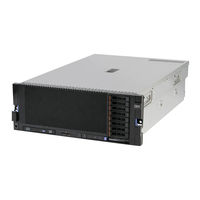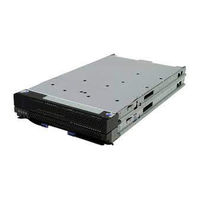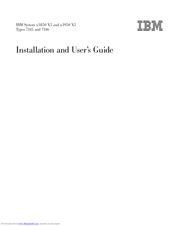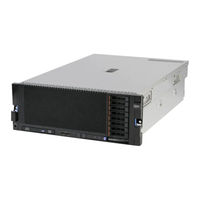
IBM System x3950 X5 Manuals
Manuals and User Guides for IBM System x3950 X5. We have 5 IBM System x3950 X5 manuals available for free PDF download: Problem Determination And Service Manual, Implementation Manual, Installation And User Manual
IBM System x3950 X5 Problem Determination And Service Manual (1064 pages)
Types 7145, 7146, 7143, and 7191
Table of Contents
-
Safety
7 -
-
-
Event Logs54
-
-
-
-
-
Passwords223
-
-
Severity: Error
464 -
SNMP Trap ID: 50
466 -
Notices
1047-
Trademarks1048
-
Important Notes1048
-
Documentation Format1050
-
-
Advertisement
IBM System x3950 X5 Implementation Manual (580 pages)
Redbooks
Table of Contents
-
Notices
13-
Trademarks14
-
-
Preface
15 -
-
Ex5 Systems22
-
Positioning27
-
-
-
-
Ex5 Chip Set36
-
Memory42
-
Max551
-
Scalability53
-
Partitioning54
-
IBM Exflash67
-
-
-
Models84
-
-
System Board86
-
-
Max588
-
Scalability90
-
Memory96
-
Storage110
-
Optical Drives122
-
Pcie Slots123
-
I/O Cards124
-
-
Product Features138
-
Target Workloads143
-
Models144
-
Max5147
-
Scalability148
-
Memory151
-
Storage165
-
Pcie Slots184
-
Riser 1185
-
Riser 2185
-
I/O Adapters188
-
-
Power Supplies193
-
Rack Mounting196
-
-
-
Introduction198
-
Target Workloads201
-
Chassis Support202
-
Models203
-
Speed Burst Card205
-
Scalability208
-
Memory214
-
Memory Options214
-
Memory Balance219
-
Memory Mirroring220
-
Memory Sparing222
-
-
Storage223
-
-
-
-
-
UEFI Settings279
-
Installing an os283
-
Local USB Port285
-
-
UEFI Settings357
-
-
-
System Alerts389
-
System Recovery391
-
-
-
Recommendations402
-
UEFI Settings416
-
-
Introduction468
-
-
Remote Control482
-
-
Systems Director488
-
IBM Serverguide521
-
Serial over LAN545
-
-
Online Resources563
-
Help from IBM563
-
Index
565
-
IBM System x3950 X5 Installation And User Manual (148 pages)
Types 7145, 7146, 7143, and 7191
Table of Contents
-
Safety
7 -
-
-
-
Notices
133-
Trademarks133
-
Important Notes134
-
Index141
-
Advertisement
IBM System x3950 X5 Installation And User Manual (136 pages)
User Manual
Table of Contents
-
Safety
9 -
-
-
-
-
Trademarks121
-
Important Notes122
-
-
IBM System x3950 X5 Installation And User Manual (102 pages)
Table of Contents
-
Safety
7 -
-
-
-
-
Trademarks91
-
-
Advertisement




